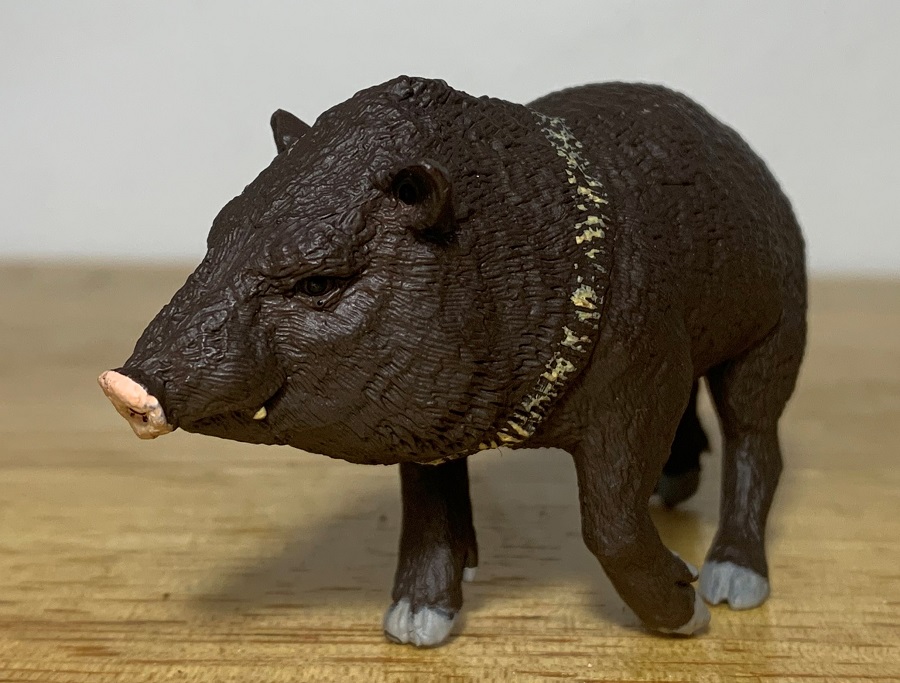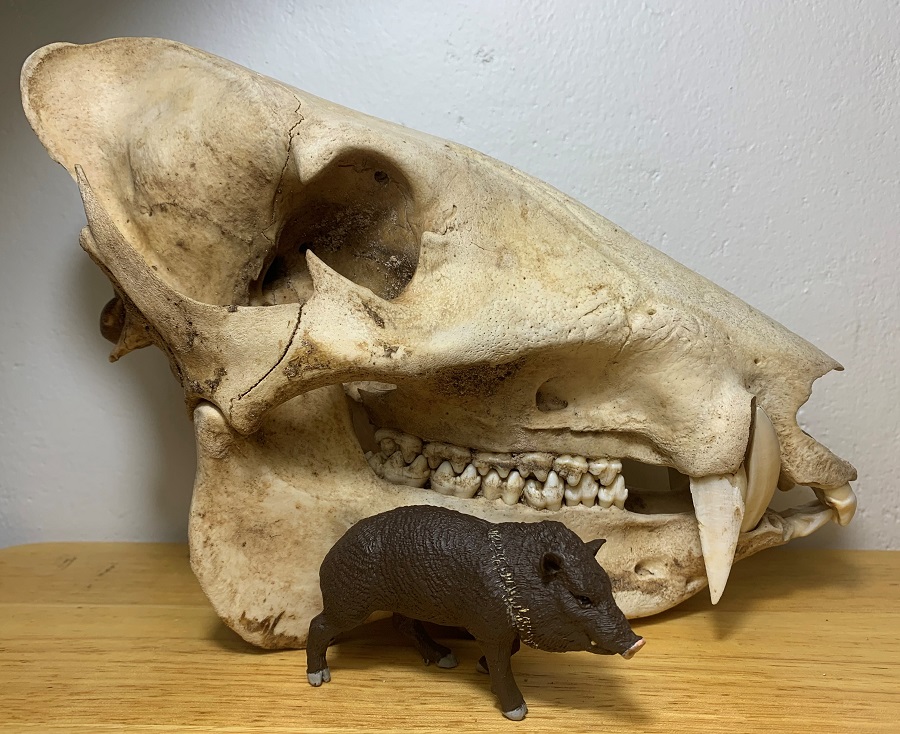Although they look very much like pigs, and are sometimes called New World pigs, peccaries aka javelinas belong to their own distinct family, Tayassuidae. Pigs belong to the family Suidae and about 30 million years of evolution separates the two families that together make up the Suina clade. While all true pig species hail from the Old World, all extant peccary species come from the Americas, although the family originally evolved in Europe. Today we’re looking at the 2014 Safari Ltd. collared peccary (Dicotyles tajacu), part of Safari’s North American Wildlife series and as far as I can tell, the only peccary figure that exists.

From nose to rump the Safari peccary measures 76.2 mm long and it stands 47.6 mm tall at the shoulder. The actual collared peccary measures about 3-4’ (0.9-1.2 meters) long and weighs 35-60 lbs. (16-27 kg). Reports of giant collared peccaries in Brazil exist and were once attributed to a different species; they’re estimated to reach 88–110 lbs. (40–50 kg). Scaled down from a 4’ specimen the Safari toy would be 1/16 in scale.

The collared peccary has a range that extends from the southwestern United States, south to northern Argentina. It is the only member of its genus but each of the 3 peccary species belongs to their own genus. The collared peccary is a social, typically diurnal animal that primarily feeds on vegetation, including roots, tubers, nuts, and fruit. They also consume cacti, including the spines with no ill effect. They will occasionally consume animal matter as well. In turn, peccaries are preyed upon by various wild canids and felids.

The Safari peccary is presented trotting along on slender legs and veering towards the right. Like a pig it has a circular, disk-shaped nose. Its small tusks can be seen sticking out of the mouth. Its eyes are appropriately small, and the ears pointed. The head appears massive in ratio to the stout body, and this is accurate. Peccaries have a body plan like pigs and the actual differences between them, although numerous, are not obvious. The figure has four digits on each forelimb and three on each hindlimb. A small tail can be seen on the rump, but this is often obscured by fur in life.

This peccary is dark brown in color with a white ring around its neck which gives the species its name. The collared peccary is also known as the musk hog due to their strong scent which originates from a gland on their rump. Collared peccaries typically have a grizzled coat with brown and gray coloration.

The nose is painted pink, the tusks white, the hooves gray, and the eyes are painted with a shiny black finish to appear wet and lifelike. A fine coat of hair is sculpted on the body which would be stiff and course in life. A mane, or ridge of hair is present running along the back of the head and neck.

The Safari collared peccary is a delightful yet diminutive figure that could be easy to overlook but shouldn’t be. No collection of North American mammals would be complete without one and this figure appears to be the only option, so thankfully it’s a well-executed figure. Unfortunately, this peccary appears to be becoming increasingly rare. Safari’s website doesn’t have it listed, and it’s not on amazon or other online stores. It might be that the figure is retired. I was able to find mine on eBay for a decent price but if this is a toy you want in your collection, I suggest purchasing it sooner than later.

Disclaimer: links to Ebay and Amazon on the AnimalToyBlog are affiliate links, so we make a small commission if you use them. Thanks for supporting us!




Ah yes, a critter from my Arizona upbringing. I heard them more than I saw them, but I have seen them. Have eaten them too :).
I really like this figure and also have it. Not a species companies outside the US are likely to tackle!
Collectible Wildlife Gifts has 39 or so of these peccaries in stock.
That’s actually where I got mine, on their eBay store. I didn’t realize that they had their own website too.